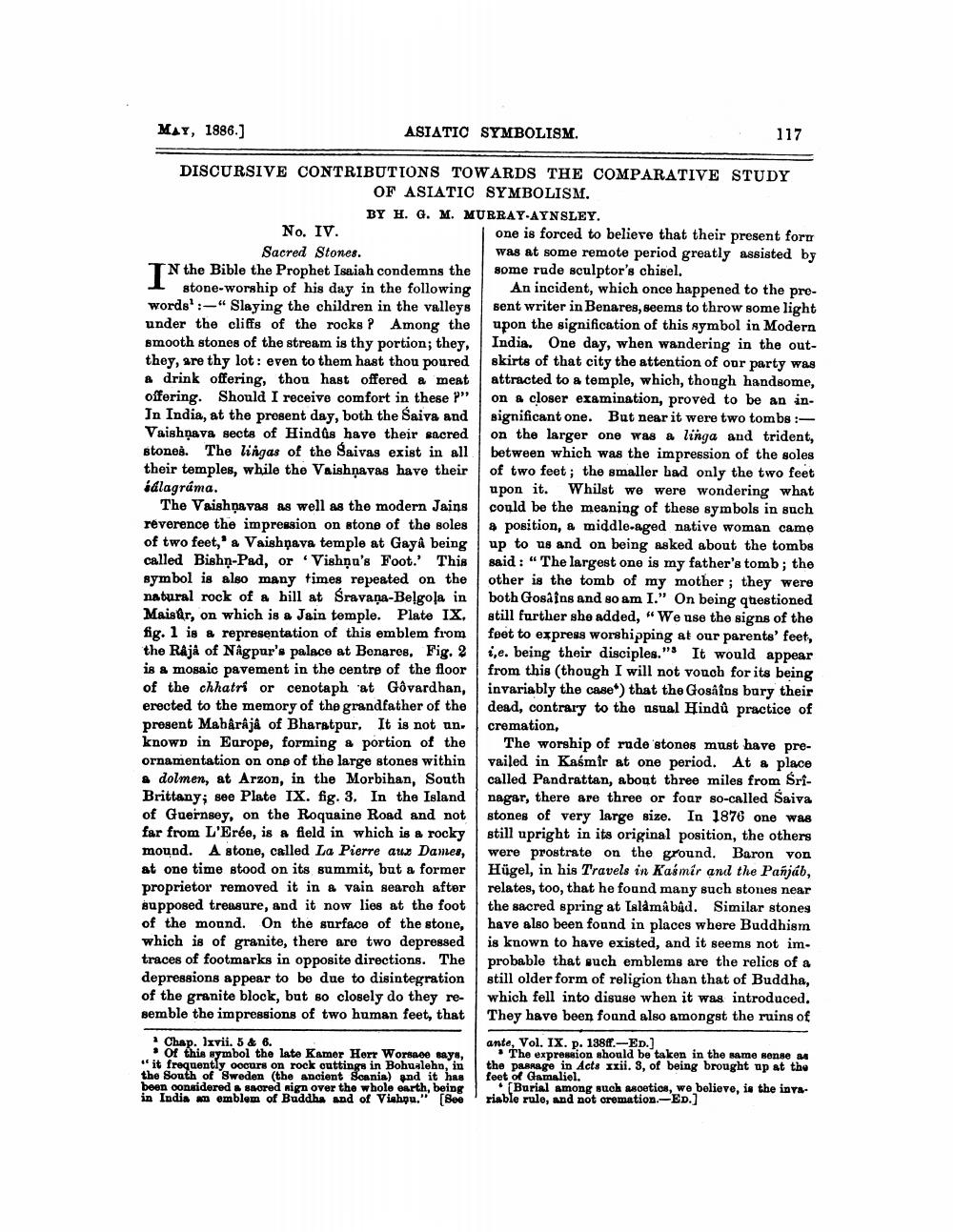________________
MAY, 1886.)
ASIATIC SYMBOLISM.
117
DISCURSIVE CONTRIBUTIONS TOWARDS THE COMPARATIVE STUDY
OF ASIATIC SYMBOLISM.
BY H. G. M. MURRAY-AYNSLEY. No. IV.
one is forced to believe that their present for Sacred Stones.
was at some remote period greatly assisted by TN the Bible the Prophet Isaiah condemns the some rude sculptor's chisel. 1 stone-worship of his day in the following An incident, which once happened to the prewords':-“ Slaying the children in the valleys sent writer in Benares, seems to throw some light under the cliffs of the rocks P Among the upon the signification of this symbol in Modern smooth stones of the stream is thy portion; they, India. One day, when wandering in the outthey, are thy lot: even to them hast thou poured skirts of that city the attention of our party was a drink offering, thou hast offered a meat attracted to a temple, which, though handsome, offering. Should I receive comfort in these !" on a closer examination, proved to be an inIn India, at the present day, both the Saiva and significant one. But near it were two tombs :Vaishnava sects of Hindus have their sacred on the larger one was a linga and trident, stones. The lingas of the Saivas exist in all between which was the impression of the soles their temples, while the Vaishnavas have their of two feet; the smaller had only the two feet idlagráma.
upon it. Whilst we were wondering what The Vaishnavas as well as the modern Jains could be the meaning of these symbols in such reverence the impression on stone of the soles a position, a middle-aged native woman came of two feet,'a Vaishộava temple at Gayâ being | up to us and on being asked about the tombs called Bishn-Pad, or Vishnu's Foot.' This said: “The largest one is my father's tomb; the symbol is also many times repeated on the other is the tomb of my mother; they were natural rock of a hill at Sravana-Belgola in both Gosains and so am I." On being questioned Maisur, on which is a Jain temple. Plate IX. still further she added, "We use the signs of the fig. 1 is a representation of this emblem from fpet to express worshipping at our parents' feet, the Raja of Nagpur's palace at Bonaros. Fig. 2 ,e. being their disciples." It would appear is a mosaic pavement in the centre of the floor from this (though I will not vonob for its being of the chhatri or cenotaph at Gôvardhan, invariably the case) that the Gosains bury their erected to the memory of the grandfather of the dead, contrary to the asual Hindú practice of prosent Maharaja of Bharatpur, It is not un. cremation, known in Europe, forming a portion of the The worship of rude 'stones must have preornamentation on one of the large stones within vailed in Kaśmir at one period. At a place
dolmen, at Arzon, in the Morbihan, South called Pandrattan, about three miles from SriBrittany; see Plate IX. fig. 3. In the Island nagar, there are three or foar so-called Saiva of Guernsey, on the Roquaine Road and not stones of very large size. In 1876 one was far from L'Erée, is a field in which is a rocky still upright in its original position, the others mound. A stone, called La Pierre au Dames, were prostrate on the ground. Baron von at one time stood on its summit, but a former Hügel, in his Travels in Kasmír and the Pañjáb, proprietor removed it in a vain search after relates, too, that he found many such stones near supposed treasure, and it now lies at the foot the sacred spring at Islamabad. Similar stones of the mound. On the surface of the stone, I have also been found in places where Buddhism which is of granite, there are two depressed is known to have existed, and it seems not imtraces of footmarks in opposite directions. The probable that such emblems are the relics of a depressions appear to be due to disintegration still older form of religion than that of Buddha, of the granite block, but so closely do they re- which fell into disuse when it was introduced semble the impressions of two human feet, that They have been found also amongst the ruins of Chap. lxvii. 5 & 6.
ante, Vol. IX. p. 138ff.-ED.) . Of this symbol the late Kamer Herr Worseee says, • The expression should be taken in the same sense
it frequently oocurs on rock cutting in Bohuslehn, in the passage in Acts xxii. S, of being brought up at the the south of Sweden (the ancient Scania) and it has feet of Gamaliel. been considered sacred sign over the whole earth, being (Burial among such moetics, we believe, is the intain India an emblem of Buddha and of Viehpu." (Bee' riable rule, and not cremation.-ED.]




